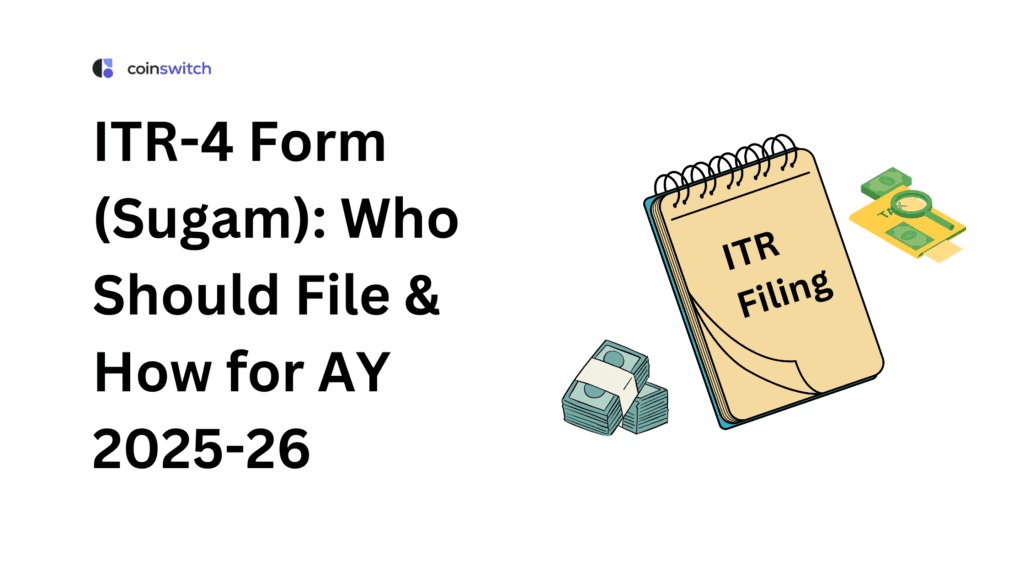Introduction of ITR-4 Form (Sugam)
Taxes are unavoidable. As a citizen of India, you are required to pay taxes on income earned from various sources and file your income tax returns to document it. However, filing income tax returns can be confusing, as there are different ITR forms to be used for each category of income earned. Some popular ITR forms include ITR-1, ITR-2, ITR-3, ITR-4, ITR-5, ITR-6, and ITR-7. In this blog post, we will discuss the basics of ITR-4, its eligibility criteria, and its relevance to crypto traders. Let’s dig in.
What is the ITR-4 (Sugam) form?
ITR-4 is an Income Tax Return (ITR) form for individuals, Hindu Undivided Family (HUF), and firms who have opted for the Presumptive Taxation Scheme under Sections 44AD, 44ADA, or 44AE. This form is meant for small business owners or professionals who prefer to avoid maintaining detailed books by declaring income at fixed rates.
Put simply, ITR-4 refers to a form used by individuals and firms who choose presumptive taxation under Sections 44AD, 44ADA, or 44AE of the Income Tax Act.
Note: ITR-4 and ITR-4 (Sugam) refer to the same form used for filing returns. It was earlier known as ITR-4S.
Eligibility criteria for filing ITR-4
The eligibility criteria for filing ITR-4 in India include the following:
- ITR-4 filing requires an individual to be a resident of India.
- It is available to individuals, HUFs, and firms, excluding Limited Liability Partnerships (LLPs).
- It applies to individuals or freelancers who have income up to ₹50 Lakh in a financial year (FY).
- ITR-4 applies to businesses or professions under the presumptive taxation scheme 44AD, 44ADA, or 44AE
- Section 44AD: For small businesses
- Section 44ADA: For professionals like doctors, architects, etc.
- Section 44AE: For individuals involved in the business of plying, hiring, or leasing goods carriages.
Who should not file ITR-4?
The ITR-4 form cannot be filed by individuals or businesses if:
- Their income is above ₹50 lakh.
- An individual’s income comes from more than one house property.
- They have capital gains, foreign income, or foreign assets.
- The taxpayer requires an audit under section 44AB.
- Companies and Limited Liability Partnerships (LLPs).
Applicability for crypto transactions
Crypto transactions usually don’t fall under the presumptive taxation scheme for which the ITR-4 form is required. Since the introduction of taxes on income from crypto, ITR forms have a specific section ‘Schedule VDA’ for reporting gains. Essentially, you must report your crypto income as capital gains or business income. Generally, ITR-2 is used for reporting capital gains, while ITR-3 is suitable for business income from crypto.
Documents required to file ITR-4
The following documents are required to file ITR-4:
- Aadhaar Card
- PAN Card
- Bank statements
- Form 16 and 16A
- Form 26AS and AIS
- Donation receipts
- Housing loan interest certificate
- Insurance premium receipts
- Rental agreement
Step-by-step process to file ITR-4
To file for an ITR-4, follow the steps below:
Step 1: Gather all the necessary documents, including income details and bank statements.
Step 2: Go to the income tax portal: https://www.incometax.gov.in
Step 3: Log in to the e-filing portal by entering the user ID and password.
Step 4: Go to the ‘e-File’ menu and click on ‘Income Tax Return.’
Step 5: Select the assessment year and choose online mode for filing.
Step 6: Choose the filing status (Individual/HUF/Firm) and select ITR-4 (Sugam).
Step 7: Fill out the form with all the necessary details, including personal information, total income, presumptive income details, deductions, and bank account details.
Step 8: Input income details from various sources. For presumptive business income, report gross turnover and declare income at the prescribed rate, provide salary details from Form 16, and other income sources.
Step 9: Claim deductions under various sections such as Section 80C, Section 80D, and Section 24(b).
Step 10: Calculate total income, apply the correct tax rates, and adjust for any advance tax or TDS paid.
Step 11: Review and submit the form online, then verify it using Aadhaar OTP, EVC (Electronic Verification Code), or by sending a signed copy to the CPC (Central Processing Centre).
Read More: Section 115BBH: Virtual Digital Assets Taxation Scheme (Cryptocurrency Tax)
Tax rates applicable under ITR-4
Under ITR-4, if a taxpayer opts for the Presumptive Taxation Scheme, their income is taxed at the normal slab rates applicable to individuals, HUFs, or firms other than LLPs.
- Section 44AD: This section applies to businesses where income is presumed to be 8% of gross turnover. However, if income is received digitally, only 6% of total receipts are considered as net income, which is then taxed accordingly.
- Section 44ADA: Section 44ADA applies to professionals like doctors and architects. This section allows certain professionals with income below ₹50 lakhs to pay tax on 50% of their gross receipts under presumptive taxation.
- Section 44AE: Section 44AE covers presumptive taxation for small businesses involved in hiring, plying, or leasing goods vehicles, where income is calculated at a fixed rate per vehicle.
Penalties for incorrect filing
Choosing or using the incorrect ITR form could result in non-reporting of income, which can attract penalties such as:
- Filing the wrong ITR could attract a notice from the Income Tax Department for incorrect disclosure.
- In case an incorrect ITR is filed, taxpayers must file a revised return using the correct ITR form before the due date to avoid penalties.
- If a taxpayer intentionally underreports their income, a penalty of 50% of the tax payable may apply.
- Likewise, in case of intentional misreporting, the penalty can be up to 200% of the tax due.
- Filing the wrong ITR may also result in the denial of tax deductions, exemptions, or carry-forward of losses.
Which ITR form is applicable for crypto, ITR-4, ITR-3, or ITR-2?
Since crypto gains are taxable in India, it is important to understand which ITR form to use while filing income tax returns. While ITR-2 and ITR-3 are relevant to crypto-related tax, ITR-4 is NOT suitable for reporting crypto income. ITR-4 applies only to individuals under presumptive taxation with simple business or professions and no capital gains or speculative income.
To be sure, ITR-2 form is ideal for individuals with capital gains from crypto trading or investments. However, if crypto trading is done frequently or professionally and is considered a business activity, an ITR-3 form is required.
Read More:
Conclusion
To sum up, ITR-4 (Sugam) is a simplified ITR filing form that offers relief to small business owners and professionals under the presumptive taxation scheme. However, it is important to note that ITR-4 is not ideal for reporting crypto income unless it fits under business income within presumptive limits. With that said, filing returns using the correct form ensures compliance and helps avoid unnecessary penalties or issues with the income tax department. As always, do your own research and consult a tax expert if you come across a roadblock while filing for ITR.
FAQs
1. Are ITR forms available for AY 2025-26?
Yes, the Income Tax Department has released ITR forms for AY 2025–26.
2. How to file ITR for crypto tax?
Since the introduction of taxes on crypto, ITR forms have a section titled VDA Schedule. To file ITR for crypto tax, taxpayers can use ITR-2 for capital gains or ITR-3 for trading or business income. The ITR forms are accessible via the Income Tax Department’s e-portal.
3. Is it compulsory to file ITR-4 for 5 years?
Filing ITR-4 for five years is not mandatory for everyone. However, if a taxpayer opts for the presumptive taxation scheme under Section 44AD, they must stick with it for five consecutive assessment years. A premature exit may result in an audit and render an individual ineligible for the scheme for the next five years.
4. When should I file ITR in 2025?
The last date to file ITR for FY 2024-25 (AY 2025-26) was 31st July 2025. However, it has now been extended to 15th September 2025. It is advisable to start your ITR filing once the Income Tax Department releases ITR forms, as ITR filings can be time-consuming, and a revised return can be submitted in case of an error.








